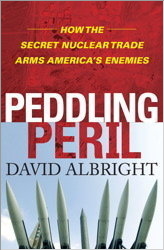The Leybold Charter: Putting Non-Proliferation Above Commercial Interests
Leybold Vacuum is a world leader in preventing its products from ending up in sensitive nuclear programs. Underpinning that commitment is the Leybold Charter, which is discussed in more detail in chapter 11 in Peddling Peril. The original Leybold Charter dates to 1992, and the most current version is from 2009 (The differences in the two versions are discussed below). Critical to the success of this initiative is the constant support of company management, which transformed a short-term turnaround in business practices in the early 1990s into a sustainable business ethic that consistently places non-proliferation over commercial interests.
Notes on the differences between the original (1992) version and the current (2009) Leybold Charter, where Leybold Vacuum is now part of Oerlikon
The main differences between the 1992 and 2009 versions are:
• In 1992, Germany had no catch-all clause for WMD and missile end uses. The German “KWKG” (best translated as War Weapons Control Act) of 1991 prohibits participation in all activities which have to do with atomic/biological/chemical weapons; at the same time it allows for a German national to participate in nuclear related activities with NATO partners. The KWKG does not mention missiles capable of delivering WMD.
• In 2005, the European Union (EU) introduced the “European Community Dual Use Regulation” which - for the first time - contained a catch-all clause for WMD and missiles (in Article 4 in original charter). At that point, the EU regulations went beyond the scope that the old Leybold Charter governed, and the Charter had to be adapted.
• The 1992 version of the Leybold Charter had a country list attached which became unnecessary after new EU legislation put all WMD and missile exports (defined as shipments to recipients outside the EU) under control.
• Leybold management changed the charter from “principles” to “directive” to reinforce the message: there is zero tolerance for violations.
• Leybold management required all employees globally to acknowledge the 2009 version by signing it.
• Today, Oerlikon Leybold Vacuum is the only remaining operation of the former “Leybold” group and uses its own version of the charter in the sense that the charter bears the signatures of all members of our Division’s Management Board.
‹ Back
News and Reviews
- The Best Books of the Year: Foreign Affairs Edition
- IEEE Review of Peddling Peril
- LA Times Book review: 'Peddling Peril'
- The New York Review of Books: Nukes for Sale
- The Tavis Smiley Show: David Albright Interviewed
- Economist review: Unstoppable?
- David Albright's Interview on NPR's Fresh Air
- David Albright on CNN's Situation Room with Wolf Blitzer
- Saddam Hussein weighed nuclear 'package' deal in 1990, documents show
Documents and Analysis
- Detecting and Disrupting Illicit Nuclear Trade after A.Q. Khan
- The Leybold Charter: Putting Non-Proliferation Above Commercial Interests
- Pakistani Government Seeks to Investigate A.Q. Khan’s Activities
- The Price of Getting Documents from A.Q. Khan: Carrying his Water
- Project AB: The Khan network's offer to Iraq regarding nuclear weapons
- P2 rotor assemblies delivered to Libya by the Khan network
- Excerpt of Peddling Peril published in Foreign Policy




